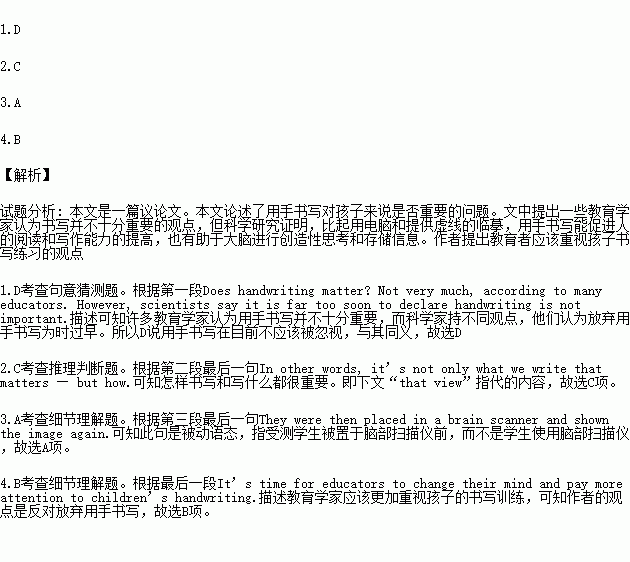题目内容
Does handwriting matter? Not very much, according to many educators. However, scientists say it is far too soon to declare handwriting is not important. New evidence suggests that the link between handwriting and educational development is deep.
Children not only learn to read more quickly when they first learn to write by hand, but they are also better able to create ideas and remember information. In other words, it’s not only what we write that matters—but how.
A study led by Karin James, a psychologist (心理学家)at Indiana University, gave support to that view. A group of children, who had not learned to read and write, were offered a letter or a shape on a card and asked to copy it in one of three ways: draw the image on a page but with a dotted outline (虚线) , draw it on a piece of blank white paper, or type it on a computer. Then the researchers put the children in a brain scanner and showed them the image again.
It was found that when children had drawn a letter freehand without a dotted outline or a computer, the activity in three areas of the brain was increased. These three areas work actively in adults when they read and write. On the contrary, children who chose the other two ways showed no such effect. Dr. James attributes the differences to the process of free handwriting: Not only must we first plan and take action in a way but we are also likely to produce a result that is variable. Those are not necessary when we have an outline.
It’s time for educators to change their minds and pay more attention to children’s handwriting.

1.What do scientists mean by saying “it is far too soon to declare handwriting is not important”?
A. Handwriting is not very important to children.
B. Handwriting has nothing to do with education.
C. Handwriting can not be learned in a short time.
D. Handwriting should not be ignored at present.
2.What does “that view” in Para. 3 refer to?
A. Children read quickly when they write by hand.
B. Children create ideas and remember information.
C. How we write is as important as what we write.
D. A group of students should know what to write.
3.Which is NOT the children’s task in the experiment?
A. Put a brain scanner and show the image again.
B. Draw the image on a piece of blank white paper.
C. Type the image directly on a computer.
D. Copy the image on a page but with a dotted outline.
4.According to the passage, the author obviously giving up handwriting.
A. is for B. is against
C. is responsible for D. doesn’t care about
 阳光课堂课时作业系列答案
阳光课堂课时作业系列答案
